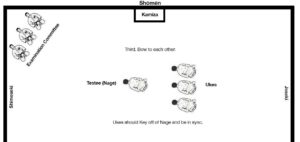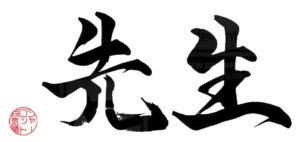Get comfortable being uncomfortable. When working with new students, I’m always fascinated with how hard it is to verbalize what we’ve been doing for years. This is especially evident when we are teaching tai sabaki. We’re just telling people how to move their feet, and it’s really hard! It’s virtually impossible for me to remember what it was like learning basic footwork back when I first started. I’m certain I wasn’t great at it and struggled to understand the basics. I’m also sure that it made me uncomfortable in a way that I hadn’t been before.
One of the things I like to tell beginners is that they will soon be surprised at how much of an aerobic workout it is falling down and getting back up again. To simply get the back sit fall right, sometimes it takes 10-15 minutes straight of Koho-tento undo. Having a new person do that, regardless of their fitness level is certainly difficult for them, and they have to do it a lot in those first few classes because there is little else they can accomplish safely. And the aerobic impact surely makes them uncomfortable, but slowly they will adapt to it as their fitness and skill levels improve.
One of my favorite quotes from Miyamoto Musashi is, “It may seem difficult at first, but everything is difficult at first.” The more I’ve practiced, the more I’ve found this to be true. Like any aikidoka, I found that I had my fair share of issues to overcome. This included losing a not insignificant amount of weight, learning basic techniques, overcoming anxiety at my first seminar, figuring out how to be a Type 1 Diabetic and an Aikidoka, taking ukemi properly, break falls, testing in front of an audience, taking correction from the instructor, etc. etc. And in order to prevail, I had to overcome feelings of uncomfortableness.
As I think about it now, I find myself uncomfortable with fewer things in Aikido. This is inevitable to be sure, but I also find it sad. Every time that I had to overcome something uncomfortable, I learned something, and it made me a different, better person and Aikidoka. Make no mistake, Aikido isn’t a “hobby;” it causes too much of a material change to who you are at your core to be that. It makes you more alert, aware, confident, fit, connected, centered, and so much more.
What I’ve discovered is that to be successful long-term with Aikido one has to embrace the feelings of being uncomfortable and learn to like it. Becoming comfortable with being uncomfortable is the only way to progress in Aikido. In my classes, I tell students while I’m doing certain stretches that they are my least favorite stretch, which is why I do them. Heck, I wasn’t even able to touch my toes when I started. I may never be as flexible as a gymnast, but when I touch my toes now, I feel pretty accomplished.
As anyone who knows me well will tell you, I’m not a morning person. There’s been research done on circadian rhythm, and essentially you are who you are in that regard. The bad news for people like me is there are no clever sayings about how the night owl gets the mouse, so it’s not generally viewed as a net positive not being a morning person. So yeah, waking up early makes me uncomfortable. However, this is something I’ve been working on with regard to attending Aikido classes. Most are surprised to see me at our 6AM Friday morning classes and that’s okay. I work on my schedule, set my alarm(s), and arrange my things to make it as easy as possible to get there for the start of class. I may never be a morning person, but I know that trying to change that about myself is making me uncomfortable, and my experience has taught me that I only grow as a person and an Aikidoka when I’m uncomfortable.
5 Questions with our Chief Instructor – Part 2
5 Questions with our Chief Instructor – Part 2 Jared Heintz: Aikido is often praised for its applicability in self-defense situations. Could you discuss how Aikido techniques can be adapted to real-world scenarios, and what mindset one should cultivate in such situations? Weiner Sensei: As I approach 25 years of Aikido practice, I’ve realized that…
Rank Testing Bowing Reiho – Advanced
Rank Testing Bowing Reiho – Advanced Andy Demko Shihan likes to say, “The little things don’t mean a lot, they mean everything”. Everyone who has practiced in our dojo or visited has seen that we take Reiho (Etiquette) pretty seriously. In all that we do, practice. Bowing. Addressing each other & more. I learned a…
Sensei
Sensei 先生 The two characters that make up the term can be directly translated as “born before,” and imply one who teaches based on wisdom gained from age and experience. In general usage, it is used, with proper form, after a person’s name and means “teacher.” In Japan, the word is also used as a…



